Experimental and Numerical Prediction of Wetting Fronts Size Created by Sub-Surface Bubble Irrigation System
Abstract
:1. Introduction
2. Materials and Methods
2.1. Experiments
2.2. Description of Bubbles Flow from ICPB
2.3. Statistical Evaluation of the Linear Regression Modelss
2.4. Estimation of Non-Sharp Wetting Fronts Resulting from ICPB by 2D HYDRUS
3. Results and Discussion
3.1. Experimental Results of BIS Wetting Patterns
3.2. Results of the 2D HYDRUS Model
3.3. Statistical Analysis
4. Conclusions
Author Contributions
Funding
Institutional Review Board Statement
Informed Consent Statement
Data Availability Statement
Conflicts of Interest
References
- Chenafi, A.; Monney, P.; Arrigoni, E.; Boudoukha, A.; Carlen, C. Influence of irrigation strategies on productivity, fruit quality and soil-plant water status of subsurface drip-irrigated apple trees. Fruits 2016, 71, 69–78. [Google Scholar] [CrossRef]
- Heard, J.; Porker, M.; Armstrong, D.; Finger, L.; Ho, C.; Wales, W.; Malcolm, B. The economics of subsurface drip irrigation on perennial pastures and fodder production in Australia. Agric. Water Manag. 2012, 111, 68–78. [Google Scholar] [CrossRef]
- Wang, Y.P.; Zhang, L.S.; Mu, Y.; Liu, W.H.; Guo, F.X.; Chang, T.R. Effect of A Root-Zone Injection Irrigation Method on Water Productivity and Apple Production in A Semi-Arid Region In North-Western China. Irrig. Drain. 2020, 69, 74–85. [Google Scholar] [CrossRef]
- Yao, W.W.; Ma, X.Y.; Li, J.; Parkes, M. Simulation of point source wetting pattern of subsurface drip irrigation. Irrig. Sci. 2011, 29, 331–339. [Google Scholar] [CrossRef]
- Elmaloglou, S.; Diamantopoulos, E. Simulation of soil water dynamics under subsurface drip irrigation from line sources. Agric. Water Manag. 2009, 96, 1587–1595. [Google Scholar] [CrossRef]
- Charlesworth, P.B.; Muirhead, W.A. Crop establishment using subsurface drip irrigation: A comparison of point and area sources. Irrig. Sci. 2003, 22, 171–176. [Google Scholar] [CrossRef]
- Philip, J. What happens near a quasi-linear point source? Water Resour. Res. 1992, 28, 47–52. [Google Scholar] [CrossRef]
- Warrick, A. Comment on “What happens near a quasi-linear point source?” by JR Philip. Water Resour. Res. 1993, 29, 3299–3300. [Google Scholar] [CrossRef]
- Shani, U.; Xue, S.; Gordin-Katz, R.; Warrick, A. Soil-limiting flow from subsurface emitters. I: Pressure measurements. J. Irrig. Drain. Eng. 1996, 122, 291–295. [Google Scholar] [CrossRef]
- Alrubaye, Y.L.; Yusuf, B. Former and Current Trend in Subsurface Irrigation Systems. Pertanika J. Sci. Technol. 2021, 29, 1–30. [Google Scholar] [CrossRef]
- Alrubaye, Y.L.; Yusuf, B.; Hamad, S.N. Development of a Self-regulated Bubble Irrigation System to Control the Size and Shape of Wetting Fronts. Pertanika J. Sci. Technol. 2020, 28, 1297–1313. [Google Scholar] [CrossRef]
- Parkin, G.W.; Gardner, W.H.; Auerswald, K.; Bouma, J.; Chesworth, W.; Morel-Seytoux, H.J. Wetting Front. In Encyclopedia of Soil Science; Chesworth, W., Ed.; Springer: Dordrecht, The Netherlands, 2008; pp. 830–835. [Google Scholar]
- Lu, N.; Likos, W. Unsaturated Soil Mechanics; John Wiley & Sons Inc.: Hoboken, NJ, USA, 2004. [Google Scholar]
- Philip, J.R. Theory of infiltration. In Advances in Hydroscience; Elsevier: Amsterdam, The Netherlands, 1969; Volume 5, pp. 215–296. [Google Scholar]
- Angelakis, A.N.; Rolston, D.E.; Kadir, T.N.; Scott, V.H. Soil-water distribution under trickle source. J. Irrig. Drain. Eng. 1993, 119, 484–500. [Google Scholar] [CrossRef]
- Chu, S.-T. Green-Ampt analysis of wetting patterns for surface emitters. J. Irrig. Drain. Eng. 1994, 120, 414–421. [Google Scholar] [CrossRef]
- Green, W.H.; Ampt, G. Studies on Soil Phyics. J. Agric. Sci. 1911, 4, 1–24. [Google Scholar] [CrossRef]
- Richards, L.A. Capillary conduction of liquids through porous mediums. Physics 1931, 1, 318–333. [Google Scholar] [CrossRef]
- Ben-Asher, J.; Charach, C.; Zemel, A. Infiltration and water extraction from trickle irrigation source: The effective hemisphere model. Soil Sci. Soc. Am. J. 1986, 50, 882–887. [Google Scholar] [CrossRef]
- Abid, H.N.; Abid, M.B. Predicting Wetting Patterns in Soil from a Single Subsurface Drip Irrigation System. J. Eng. 2019, 25, 41–53. [Google Scholar] [CrossRef]
- Ali, S.; Ghosh, N.C. Methodology for the estimation of wetting front length and potential recharge under variable depth of ponding. J. Irrig. Drain. Eng. 2015, 142, 04015027. [Google Scholar] [CrossRef]
- Dawood, I.A.; Hamad, S.N. Movement of Irrigation Water in Soil from a Surface Emitter. J. Eng. 2016, 22, 103–114. [Google Scholar]
- Fan, W.; Li, G. Effect of soil properties on Hydraulic characteristics under subsurface drip irrigation. IOP Conf. Ser. Earth Environ. Sci. 2018, 121, 052042. [Google Scholar] [CrossRef]
- Ren, C.; Zhao, Y.; Dan, B.; Wang, J.; Gong, J.; He, G. Lateral hydraulic performance of subsurface drip irrigation based on spatial variability of soil: Experiment. Agric. Water Manag. 2018, 204, 118–125. [Google Scholar] [CrossRef]
- Fan, Y.; Huang, N.; Gong, J.; Shao, X.; Zhang, J.; Zhao, T. A simplified infiltration model for predicting cumulative infiltration during vertical line source irrigation. Water 2018, 10, 89. [Google Scholar] [CrossRef]
- Fan, Y.-W.; Huang, N.; Zhang, J.; Zhao, T. Simulation of soil wetting pattern of vertical moistube-irrigation. Water 2018, 10, 601. [Google Scholar] [CrossRef]
- Cai, Y.; Wu, P.; Zhang, L.; Zhu, D.; Chen, J.; Wu, S.; Zhao, X. Simulation of soil water movement under subsurface irrigation with porous ceramic emitter. Agric. Water Manag. 2017, 192, 244–256. [Google Scholar] [CrossRef]
- Cai, Y.; Wu, P.; Zhang, L.; Zhu, D.; Wu, S.; Zhao, X.; Chen, J.; Dong, Z. Prediction of flow characteristics and risk assessment of deep percolation by ceramic emitters in loam. J. Hydrol. 2018, 566, 901–909. [Google Scholar] [CrossRef]
- Cai, Y.; Zhao, X.; Wu, P.; Zhang, L.; Zhu, D.; Chen, J. Effect of Soil Texture on Water Movement of Porous Ceramic Emitters: A Simulation Study. Water 2019, 11, 22. [Google Scholar] [CrossRef]
- Cai, Y.; Zhao, X.; Wu, P.; Zhang, L.; Zhu, D.; Chen, J.; Lin, L. Ceramic patch type subsurface drip irrigation line: Construction and hydraulic properties. Biosyst. Eng. 2019, 182, 29–37. [Google Scholar] [CrossRef]
- Lima, V.; Keitel, C.; Sutton, B.; Leslie, G. Improved water management using subsurface membrane irrigation during cultivation of Phaseolus vulgaris. Agric. Water Manag. 2019, 223, 105730. [Google Scholar] [CrossRef]
- Saefuddin, R.; Saito, H.; Šimůnek, J. Experimental and numerical evaluation of a ring-shaped emitter for subsurface irrigation. Agric. Water Manag. 2019, 211, 111–122. [Google Scholar] [CrossRef]
- Malek, K.; Peters, R.T. Wetting pattern models for drip irrigation: New empirical model. J. Irrig. Drain. Eng. 2011, 137, 530–536. [Google Scholar] [CrossRef]
- Gao, Y.; Li, Z.; Sun, D.A.; Yu, H. A simple method for predicting the hydraulic properties of unsaturated soils with different void ratios. Soil Tillage Res. 2021, 209, 104913. [Google Scholar] [CrossRef]
- Van Genuchten, M.T. A closed-form equation for predicting the hydraulic conductivity of unsaturated soils 1. Soil Sci. Soc. Am. J. 1980, 44, 892–898. [Google Scholar] [CrossRef]
- DiCarlo, D.A. Quantitative network model predictions of saturation behind infiltration fronts and comparison with experiments. Water Resour. Res. 2006, 42, 9. [Google Scholar] [CrossRef]
- Kisi, O.; Khosravinia, P.; Heddam, S.; Karimi, B.; Karimi, N. Modeling wetting front redistribution of drip irrigation systems using a new machine learning method: Adaptive neuro-fuzzy system improved by hybrid particle swarm optimization–Gravity search algorithm. Agric. Water Manag. 2021, 256, 107067. [Google Scholar] [CrossRef]
- Lazarovitch, N.; Warrick, A.; Furman, A.; Simunek, J. Subsurface water distribution from drip irrigation described by moment analyses. Vadose Zone J. 2007, 6, 116–123. [Google Scholar] [CrossRef] [Green Version]
- AL-Sammak, A.S. Wetting Pattern Characteristics of Unsaturated Flow Created by Free and Bubbles Subsurface Sources. Master Thesis, Universiti Purta Malaysia, Shaden, Malaysia, 2021. [Google Scholar]
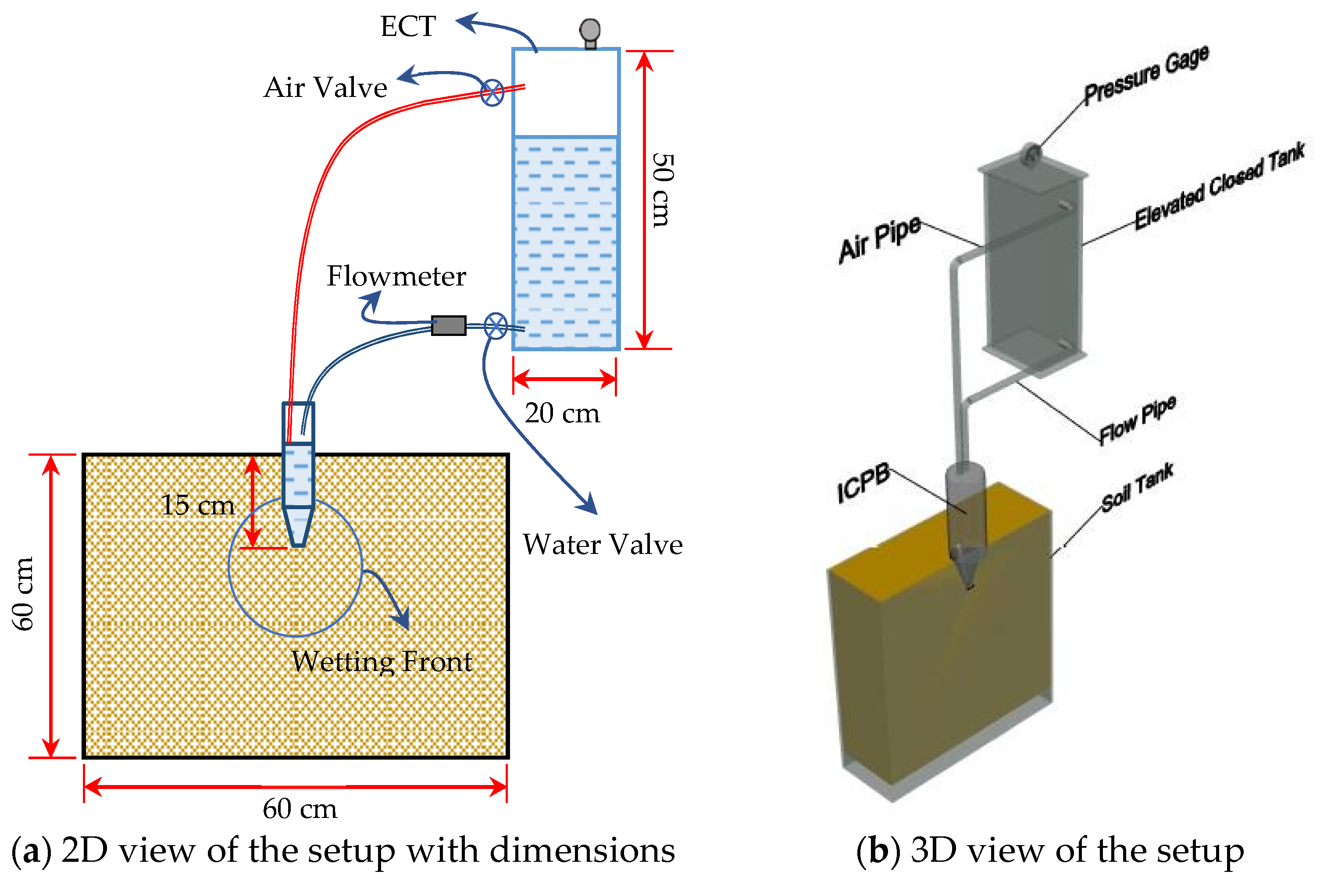
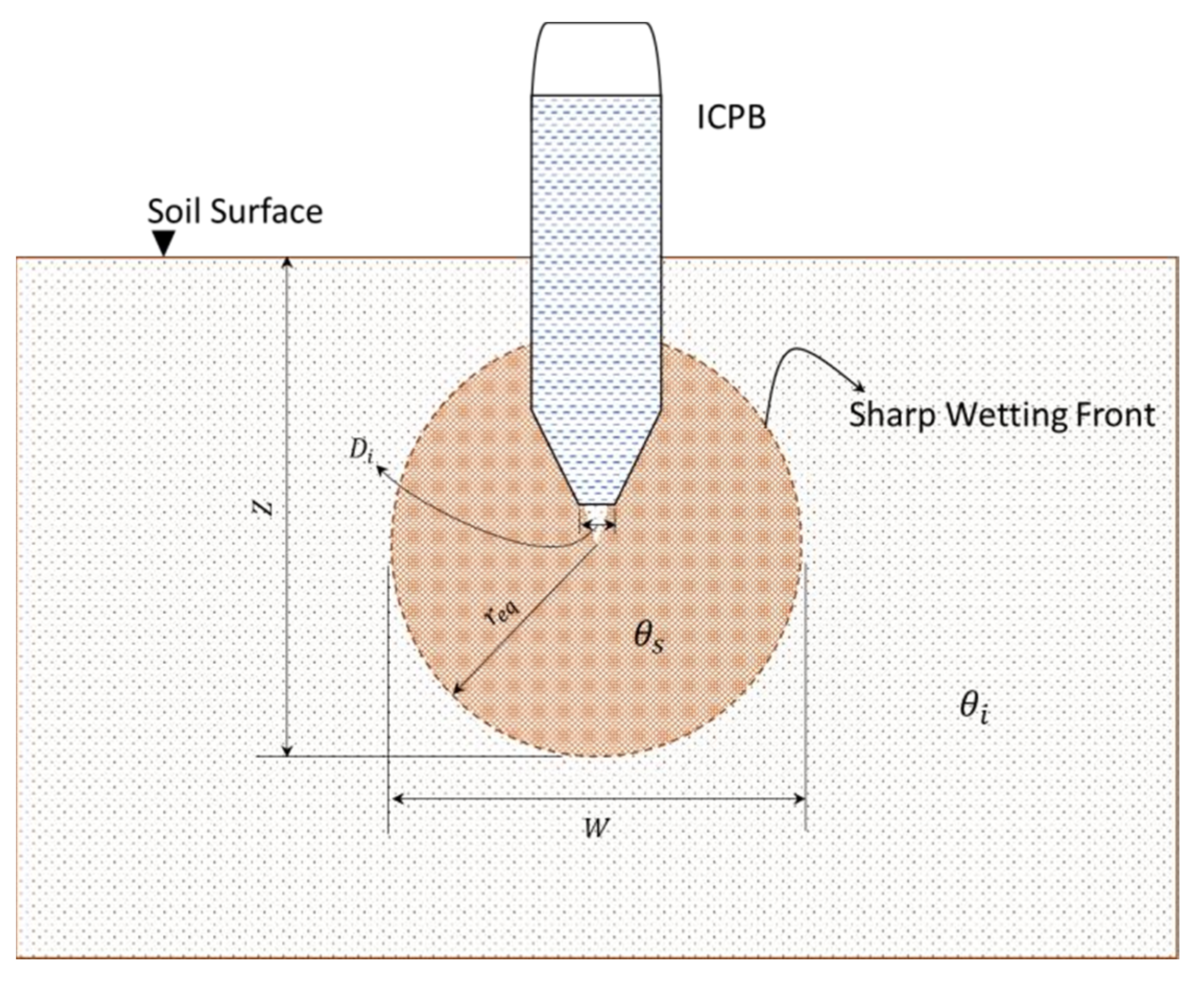


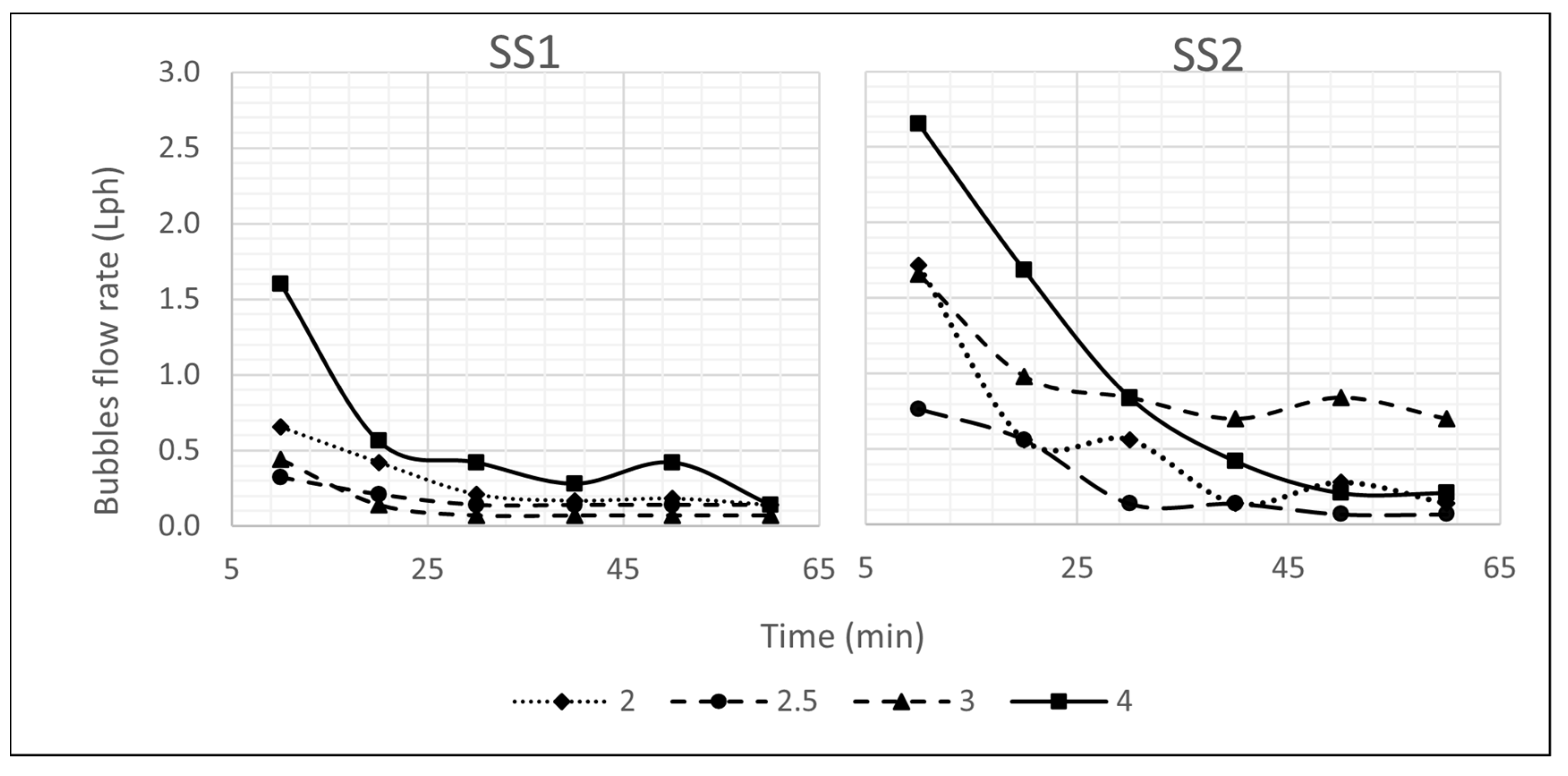
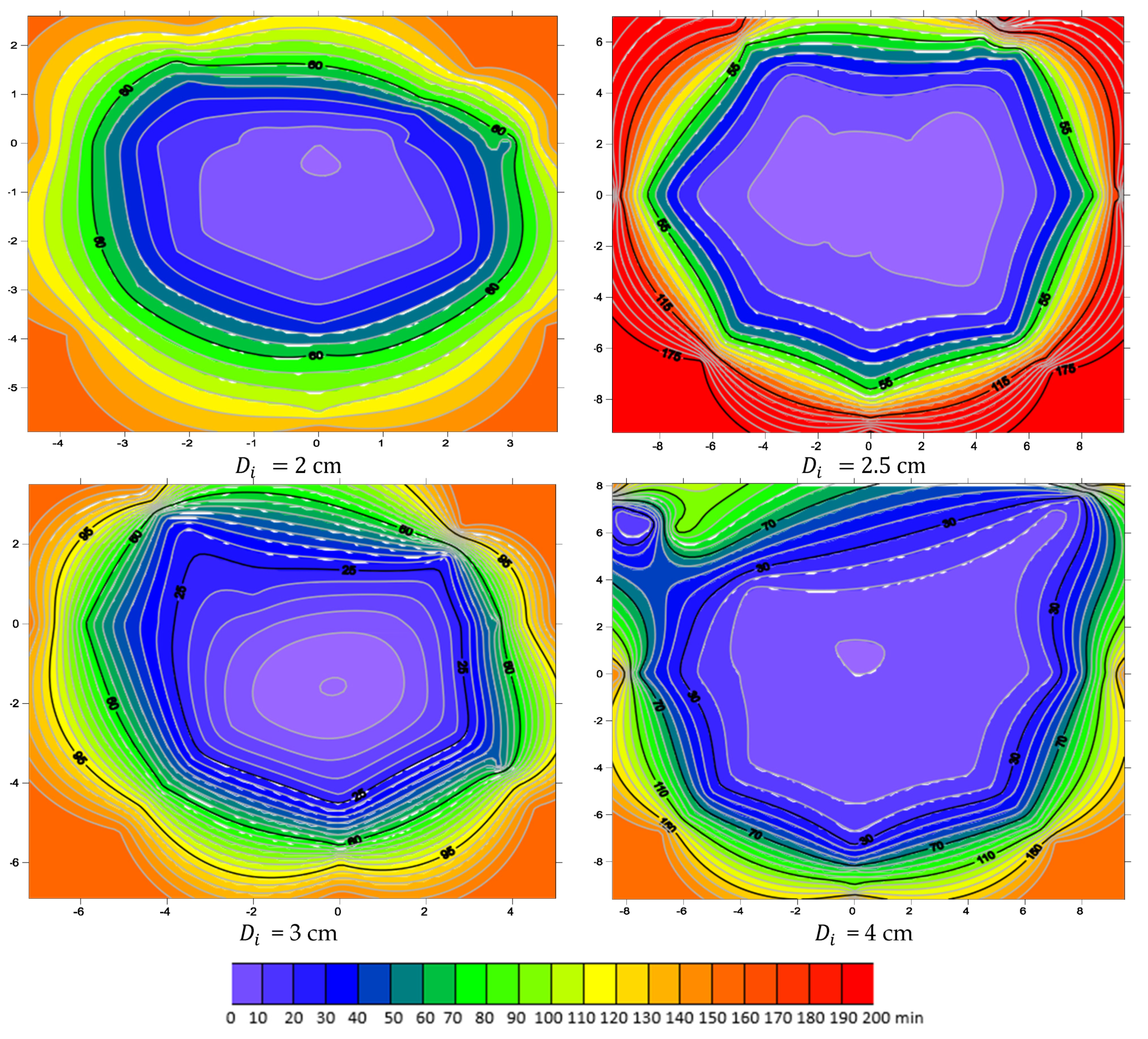
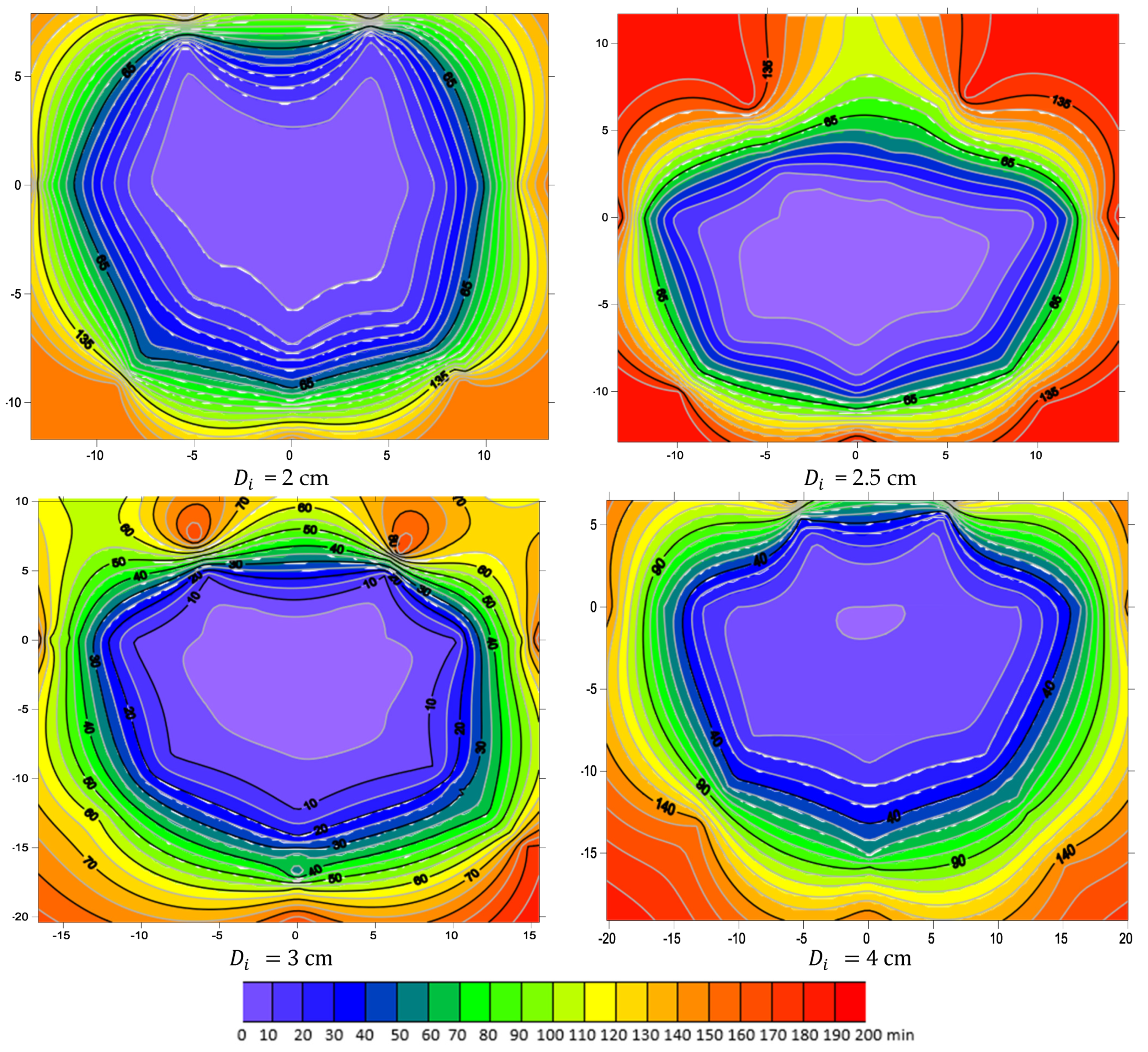
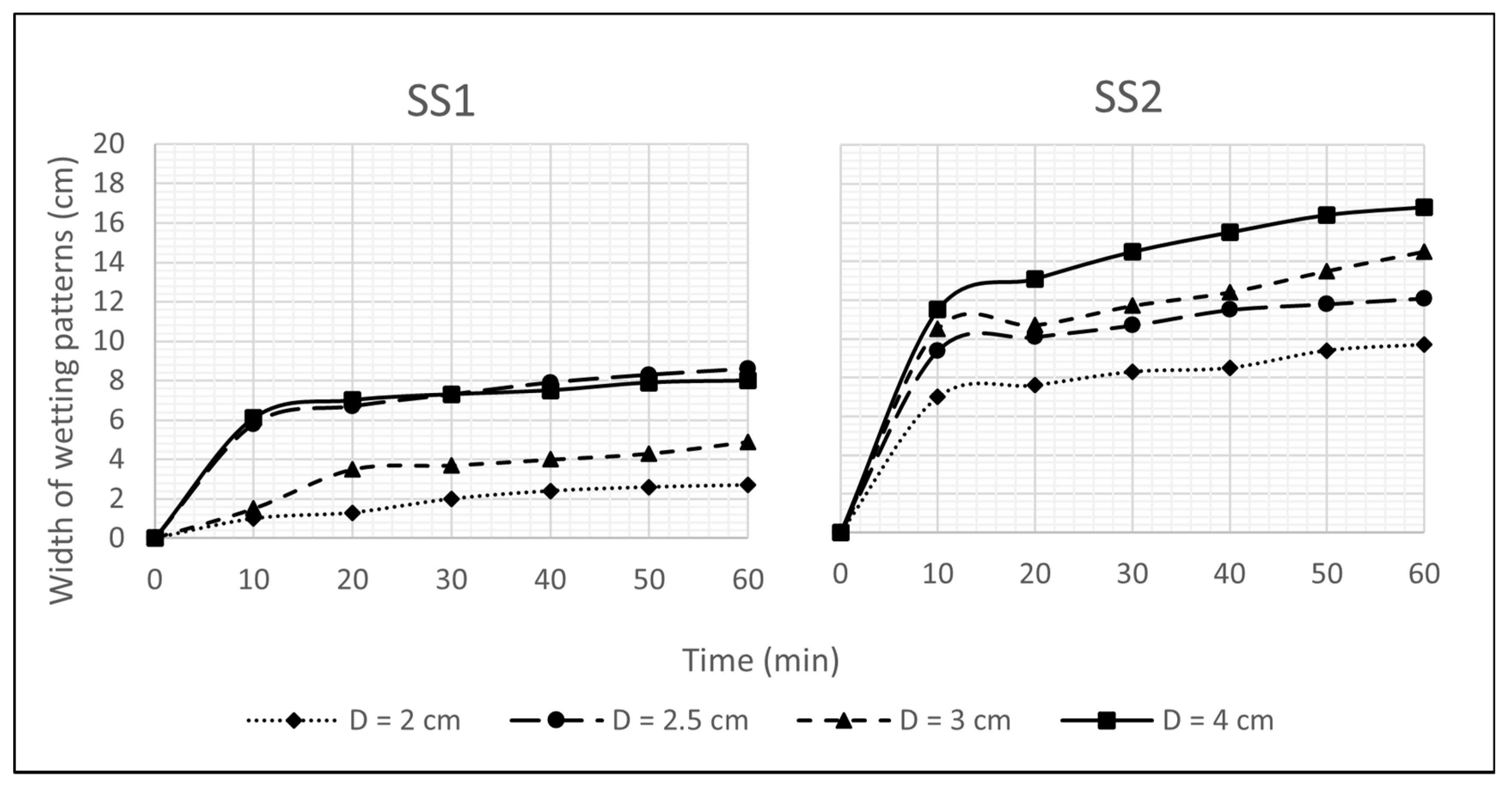
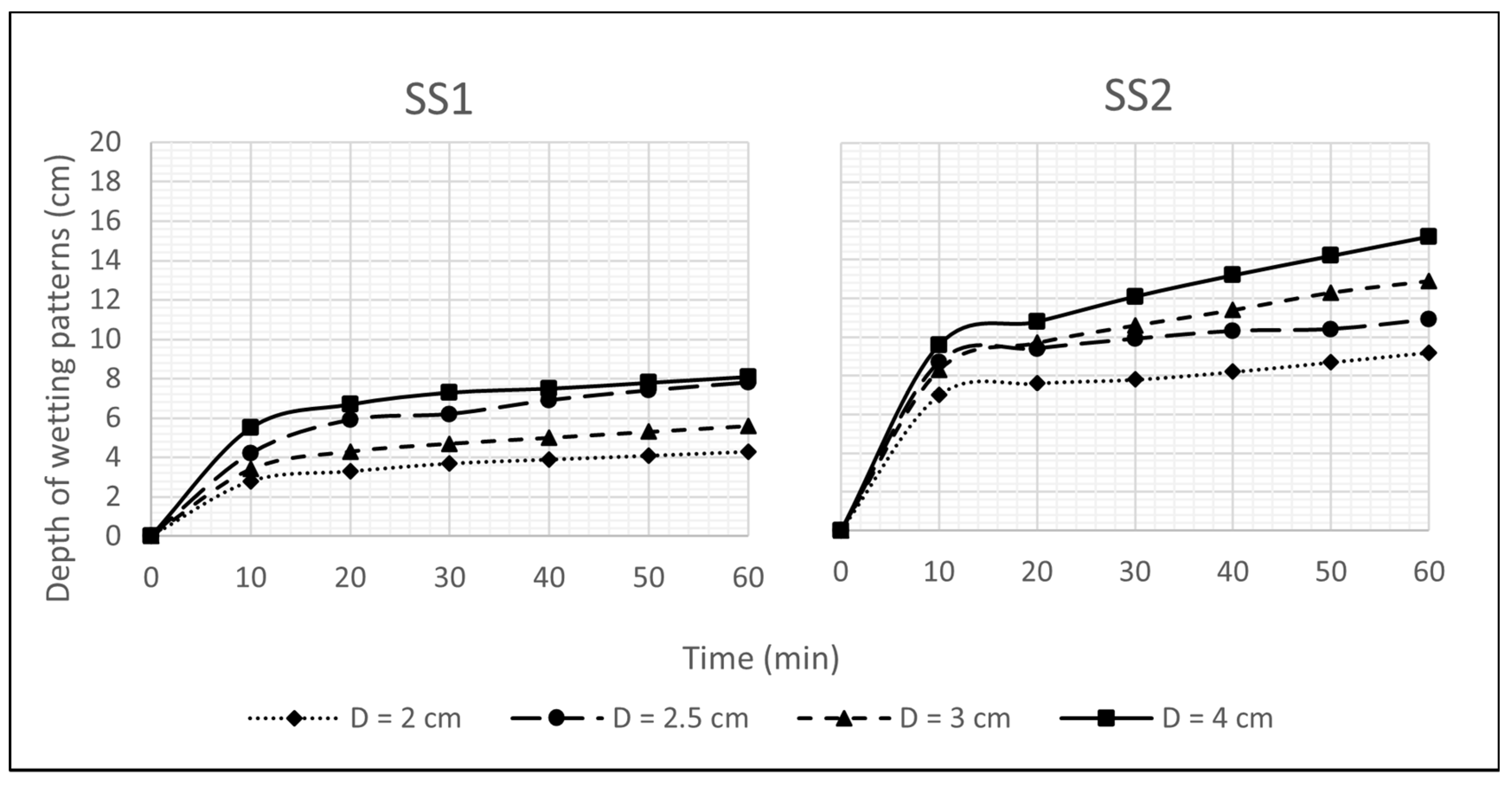
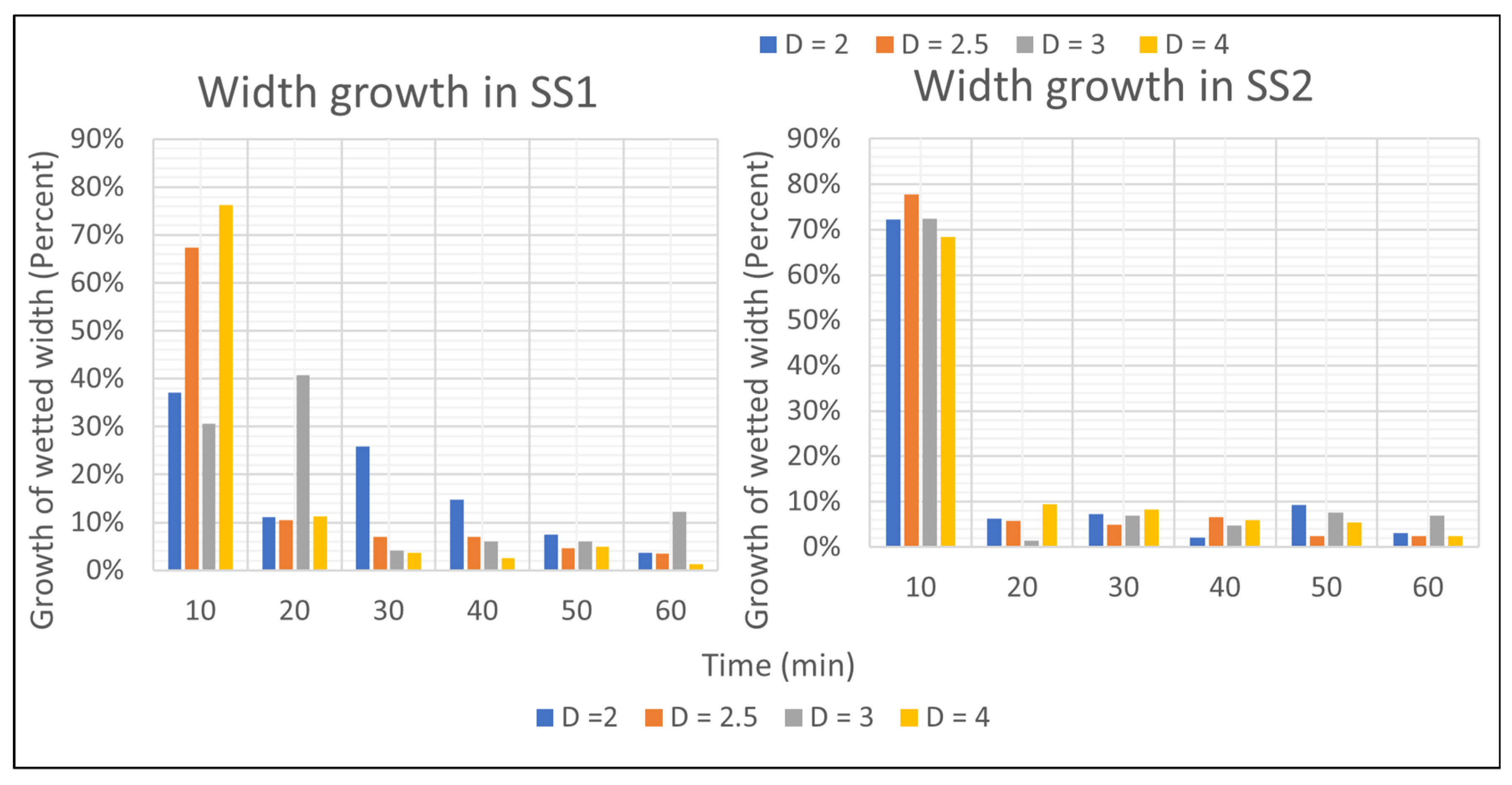
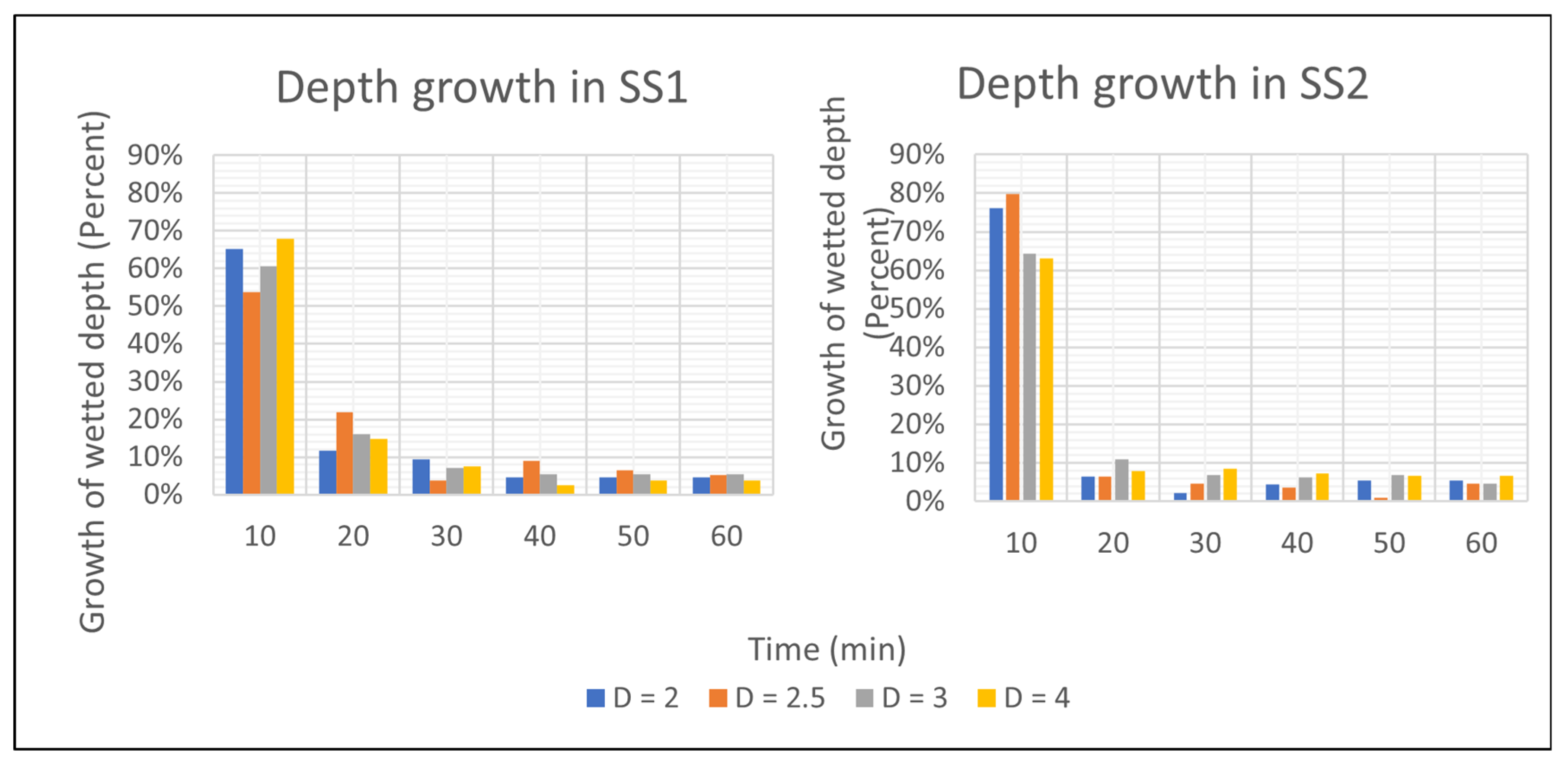

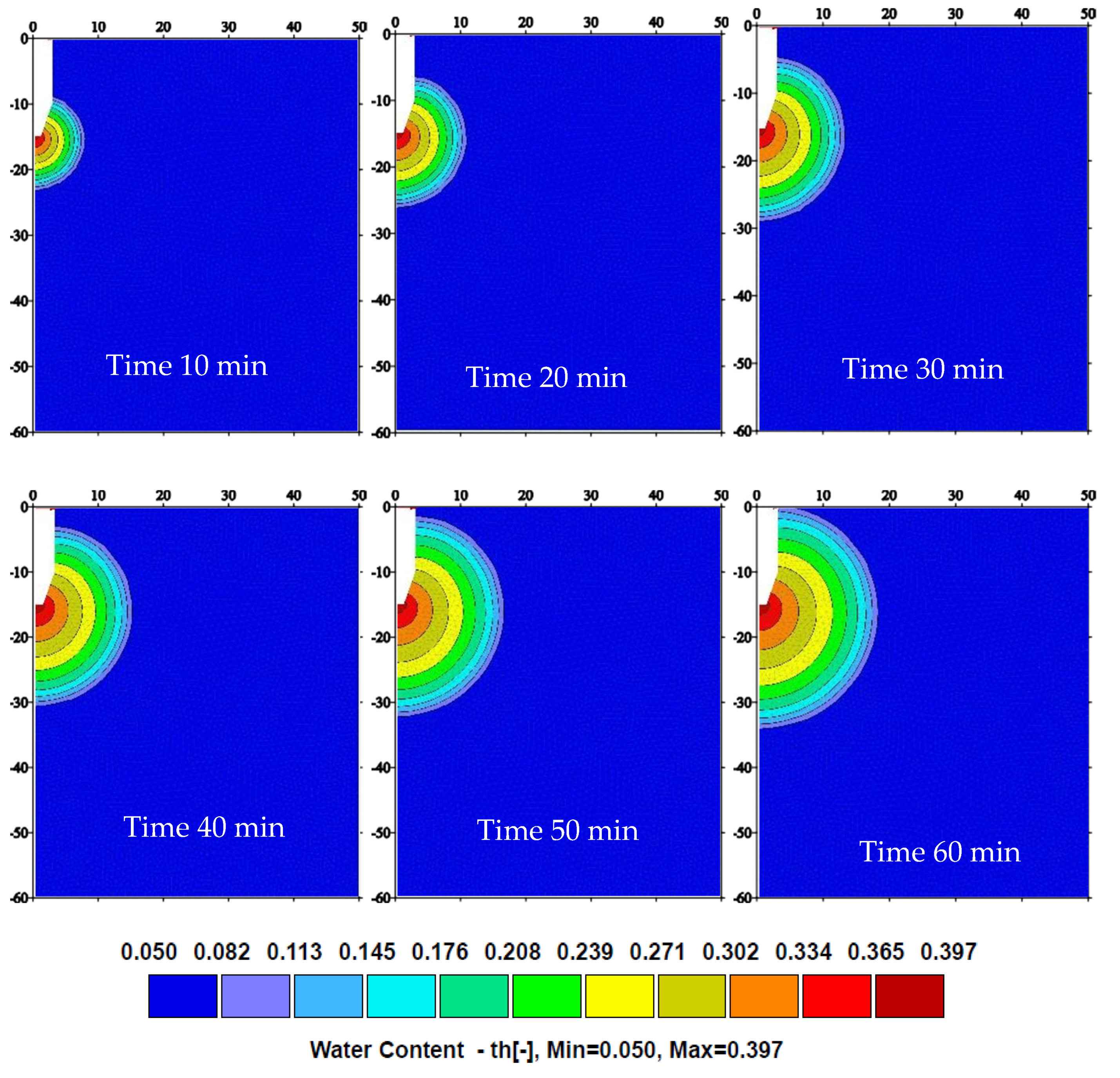
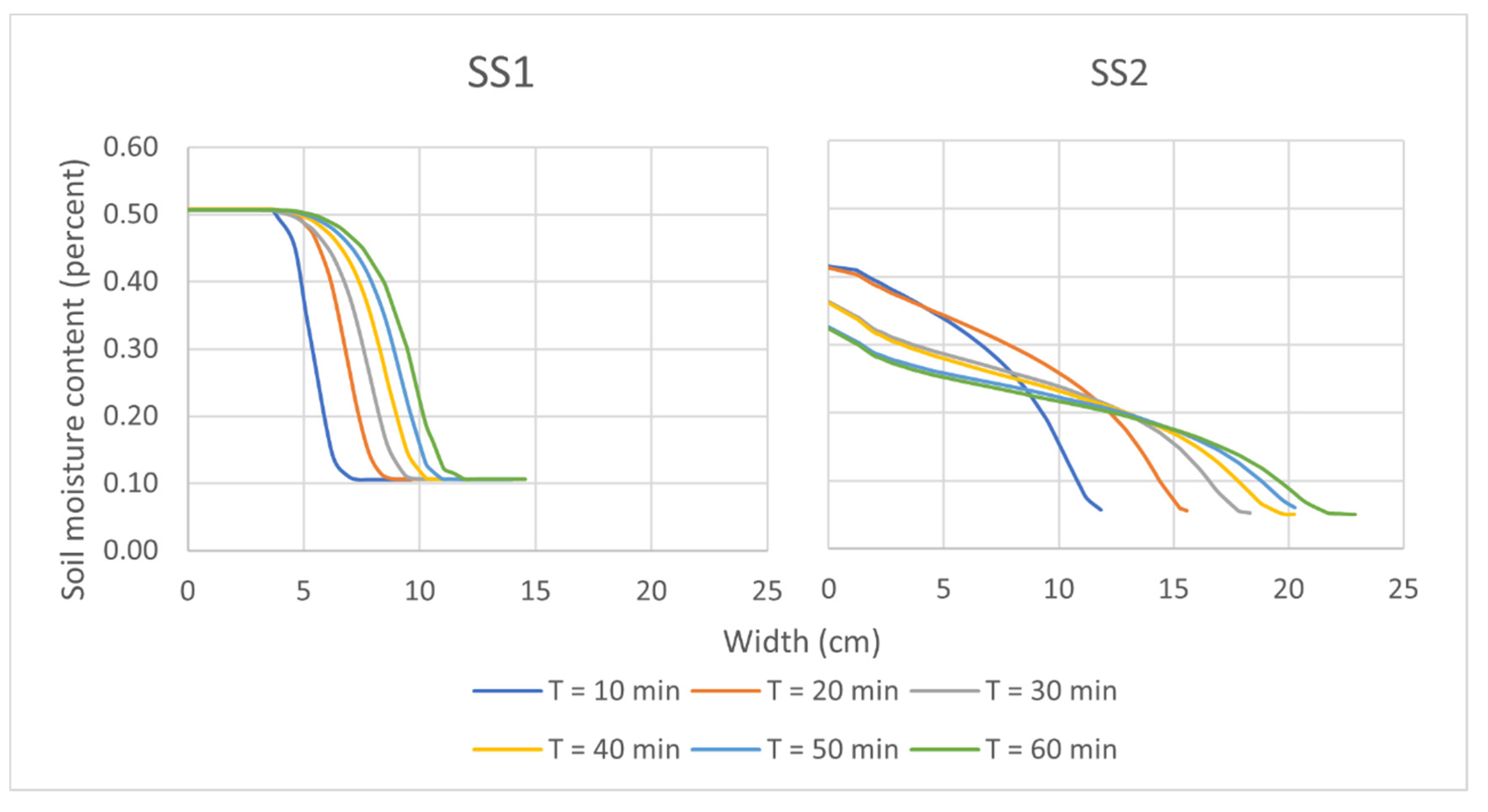
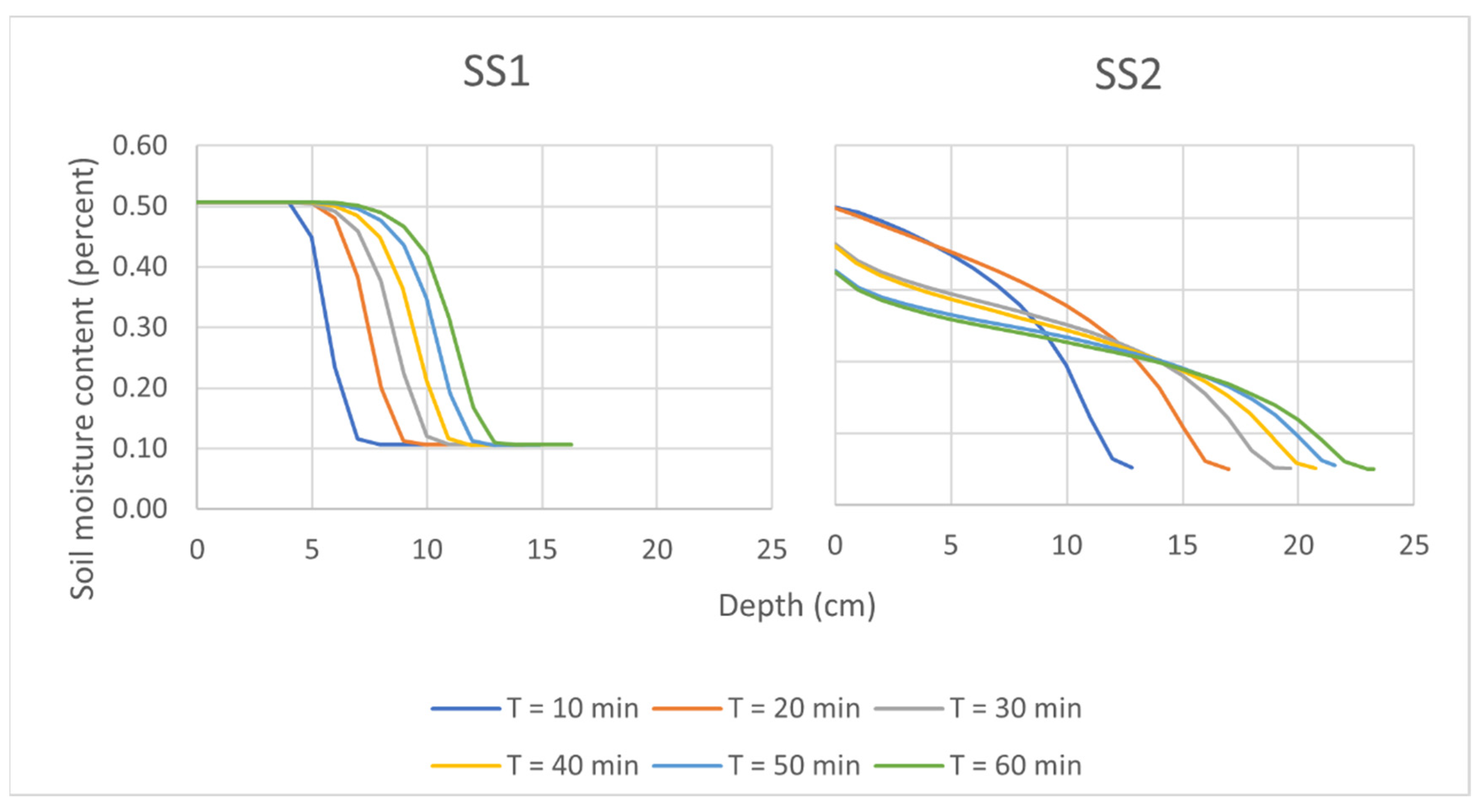
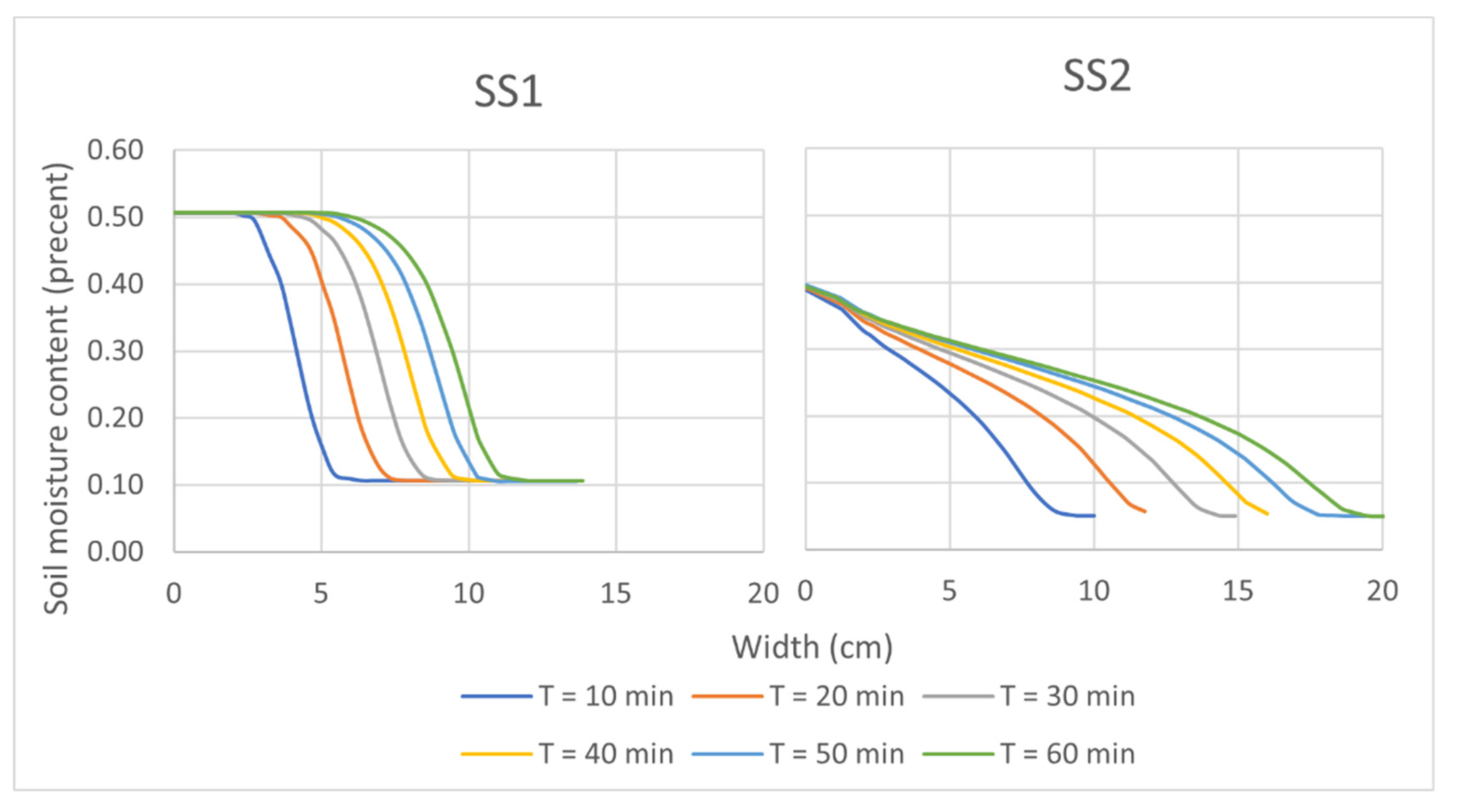
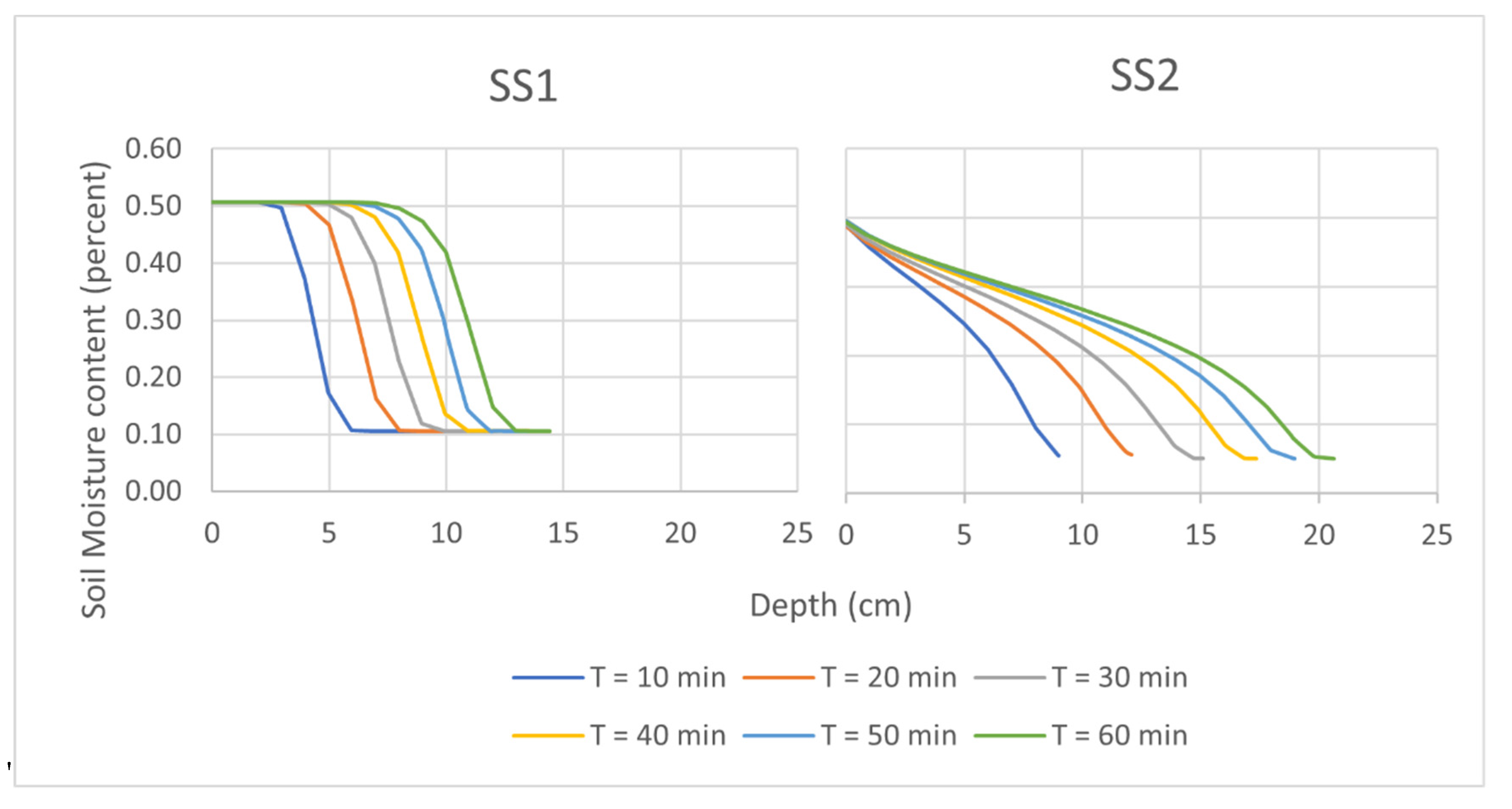
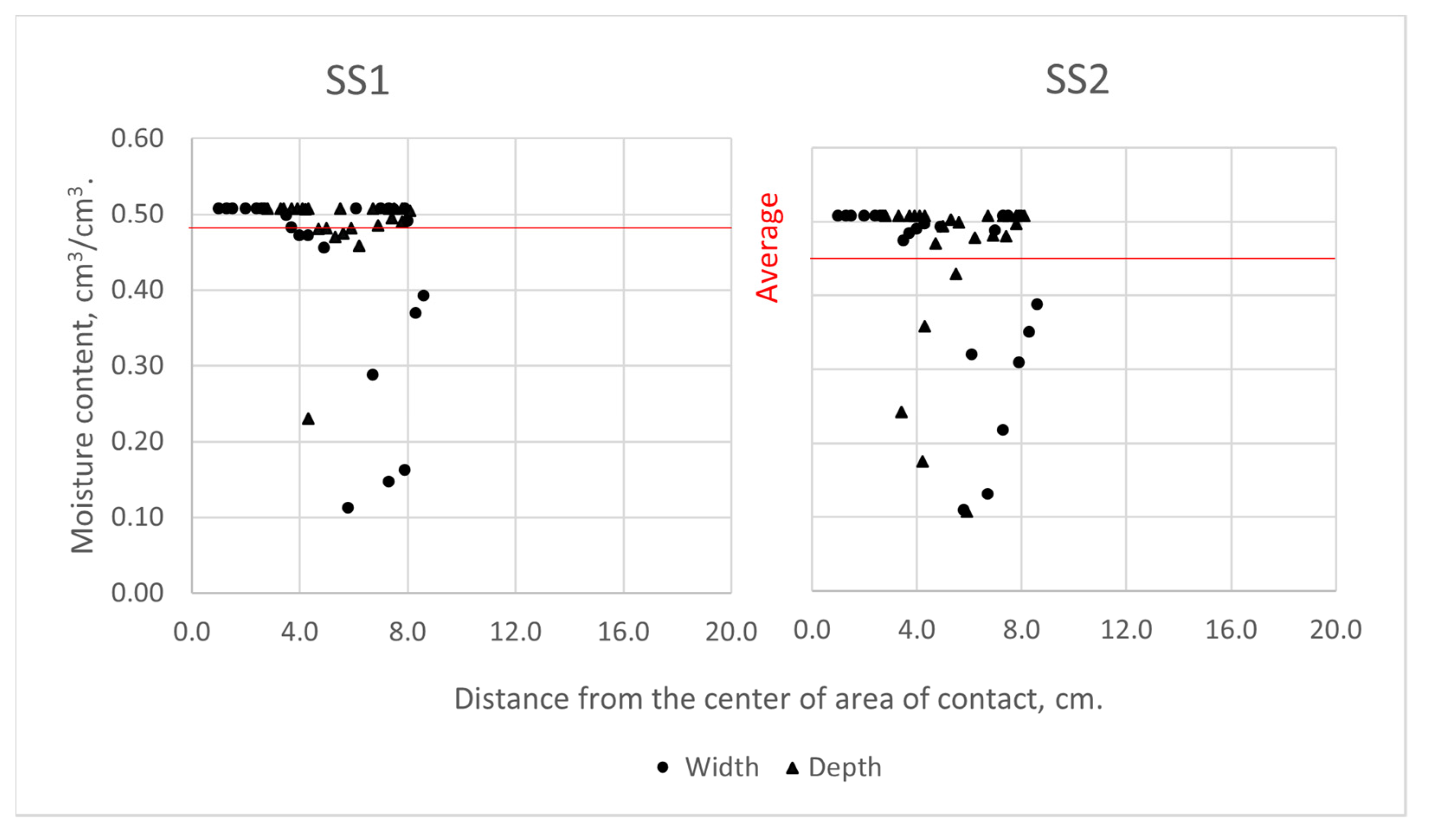
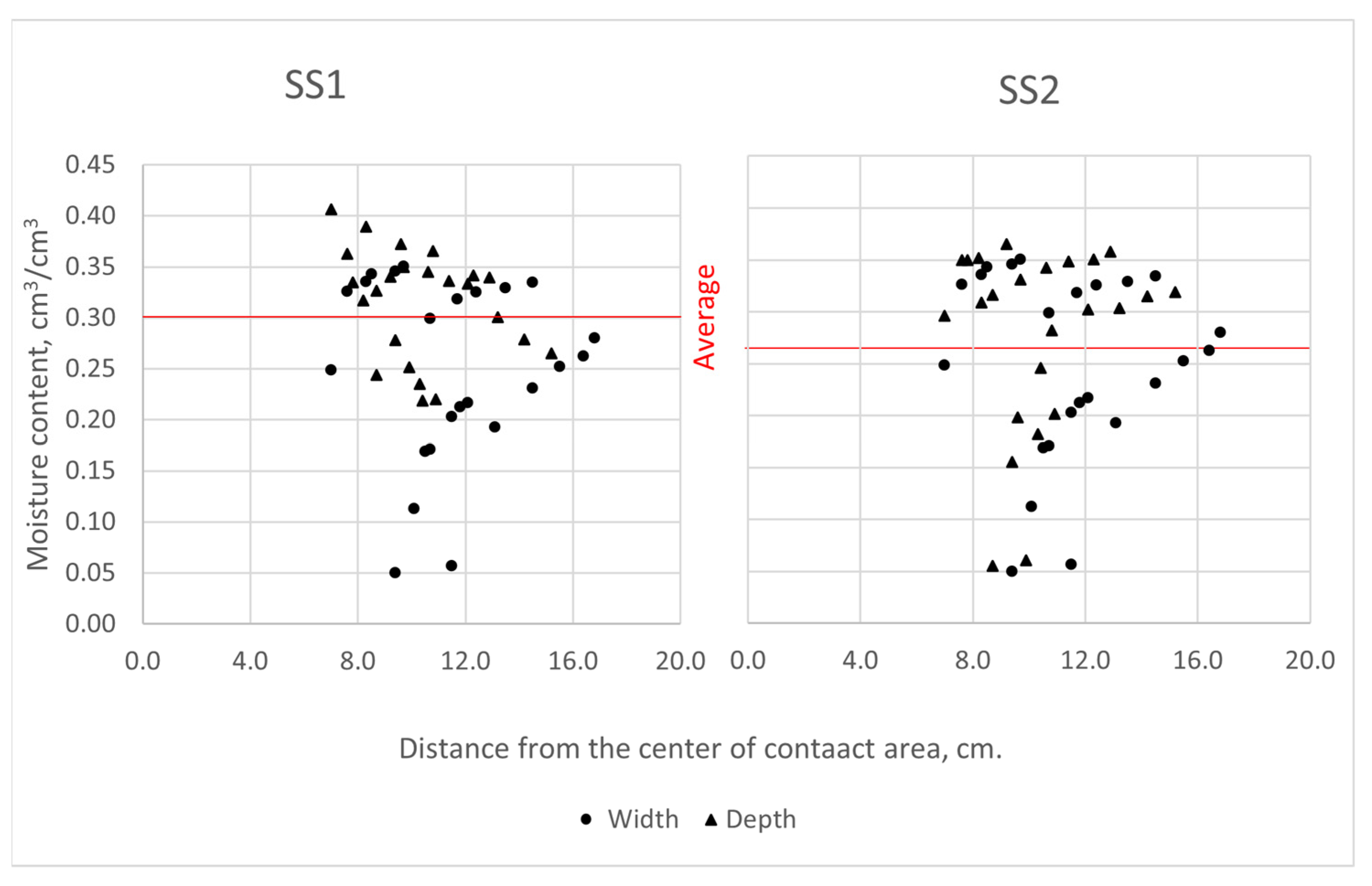
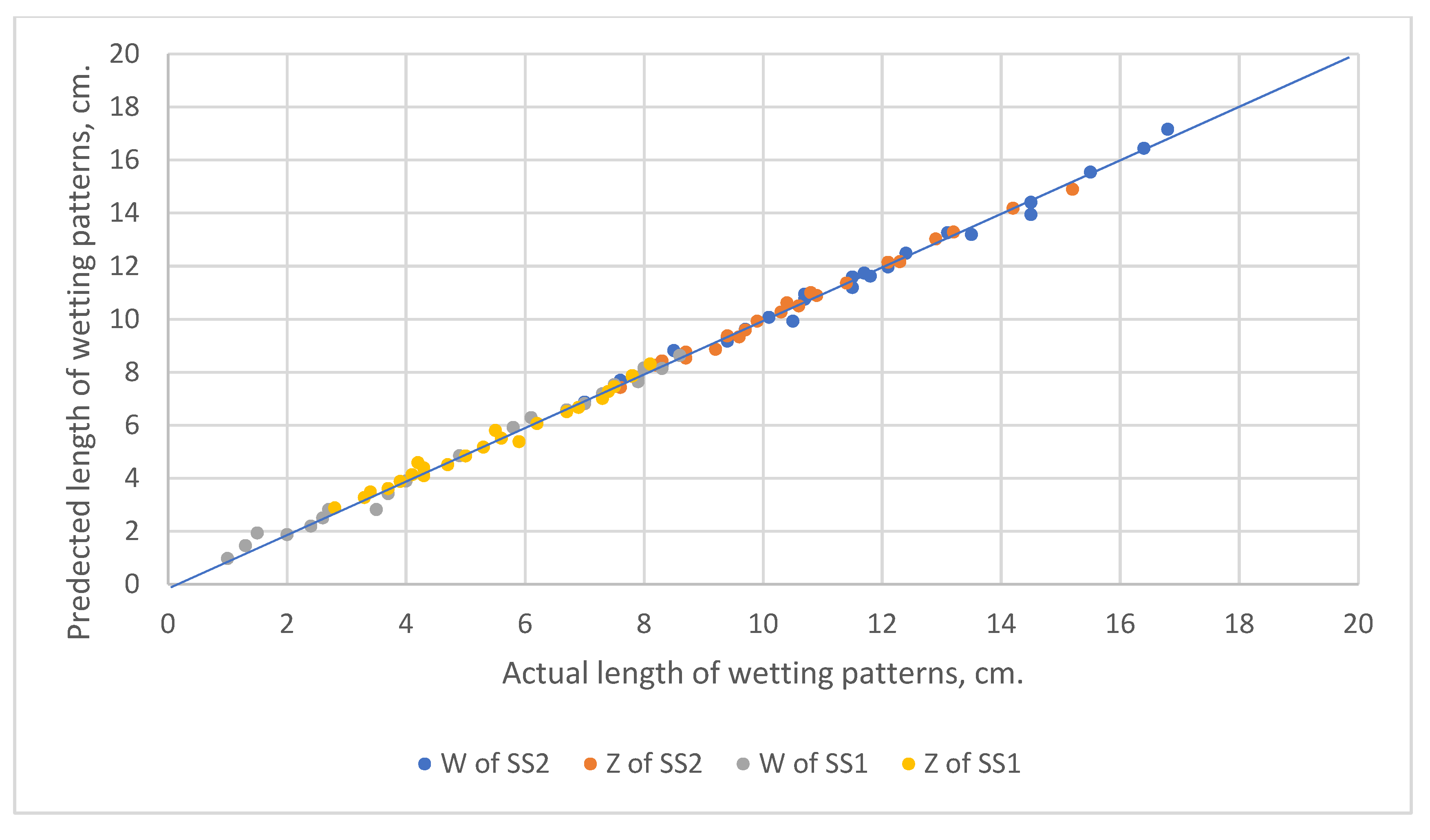
| Cases | Diameters of Contact Area, Di. cm | Soils |
|---|---|---|
| 1 | 2 | SS1 and SS2 |
| 2 | 2.5 | |
| 3 | 3 | |
| 4 | 4 |
| Soil Type | Texture | ks, cm/h | Bulk Density, gm/cm3 | θi | θ fc | ||
|---|---|---|---|---|---|---|---|
| Sand | Silt | Clay | |||||
| SS1 | 92% | 8% | 0% | 1.19 | 1.19 | 5% | 58% |
| SS2 | 97% | 3% | 0% | 1.85 | 1.45 | 5% | 33% |
| Cases | Soil Type | Di, cm. | θr, cm3/cm3 | θs, cm3/cm3 | α | n | ks, cm/min | l |
|---|---|---|---|---|---|---|---|---|
| 1 | SS1 | 2 | 0.1053 | 0.5071 | 0.05 | 2 | 0.01979 | 0.5 |
| 2 | SS1 | 2.5 | 0.1053 | 0.5071 | 0.05 | 2 | 0.01979 | 0.5 |
| 3 | SS1 | 3 | 0.1053 | 0.5071 | 0.05 | 2 | 0.01979 | 0.5 |
| 4 | SS1 | 4 | 0.1053 | 0.5071 | 0.05 | 2 | 0.01979 | 0.5 |
| 5 | SS2 | 2 | 0.0473 | 0.415 | 0.0032 | 2.7 | 0.03087 | 0.5 |
| 6 | SS2 | 2.5 | 0.0473 | 0.415 | 0.0032 | 2.7 | 0.03087 | 0.5 |
| 7 | SS2 | 3 | 0.0473 | 0.415 | 0.0032 | 2.7 | 0.03087 | 0.5 |
| 8 | SS2 | 4 | 0.0473 | 0.415 | 0.0032 | 2.7 | 0.03087 | 0.5 |
| Diameters of the Contact Area (cm) | Soil Type | |
|---|---|---|
| SS1 | SS2 | |
| 2 | 0.296 | 0.567 |
| 2.5 | 0.183 | 0.291 |
| 3 | 0.144 | 0.955 |
| 4 | 0.571 | 1.004 |
| K | Diameters | Width Parameters (w) | Depth Parameters (z) | ||||
|---|---|---|---|---|---|---|---|
| C | D | R2 | A | B | R2 | ||
| SS1 | 2 | 0.50 | 0.11 | 0.96 | 2.49 | 0.09 | 0.98 |
| 2.5 | 5.23 | 0.19 | 0.98 | 3.75 | 0.23 | 0.94 | |
| 3 | 1.06 | 0.23 | 0.89 | 2.87 | 0.16 | 0.98 | |
| 4 | 5.76 | 0.09 | 0.95 | 5.10 | 0.12 | 0.94 | |
| SS2 | 2 | 6.06 | 0.12 | 0.96 | 6.20 | 0.09 | 0.96 |
| 2.5 | 8.48 | 0.15 | 0.99 | 8.10 | 0.12 | 0.98 | |
| 3 | 8.90 | 0.14 | 0.95 | 7.26 | 0.16 | 0.99 | |
| 4 | 9.93 | 0.17 | 0.99 | 7.67 | 0.17 | 0.99 | |
Publisher’s Note: MDPI stays neutral with regard to jurisdictional claims in published maps and institutional affiliations. |
© 2022 by the authors. Licensee MDPI, Basel, Switzerland. This article is an open access article distributed under the terms and conditions of the Creative Commons Attribution (CC BY) license (https://creativecommons.org/licenses/by/4.0/).
Share and Cite
Alrubaye, Y.L.; Yusuf, B.; Mohammad, T.A.; Nahazanan, H.; Zawawi, M.A.M. Experimental and Numerical Prediction of Wetting Fronts Size Created by Sub-Surface Bubble Irrigation System. Sustainability 2022, 14, 11492. https://doi.org/10.3390/su141811492
Alrubaye YL, Yusuf B, Mohammad TA, Nahazanan H, Zawawi MAM. Experimental and Numerical Prediction of Wetting Fronts Size Created by Sub-Surface Bubble Irrigation System. Sustainability. 2022; 14(18):11492. https://doi.org/10.3390/su141811492
Chicago/Turabian StyleAlrubaye, Yasir L., Badronnisa Yusuf, Thamer A. Mohammad, Haslinda Nahazanan, and Mohamed Azwan Mohamed Zawawi. 2022. "Experimental and Numerical Prediction of Wetting Fronts Size Created by Sub-Surface Bubble Irrigation System" Sustainability 14, no. 18: 11492. https://doi.org/10.3390/su141811492
APA StyleAlrubaye, Y. L., Yusuf, B., Mohammad, T. A., Nahazanan, H., & Zawawi, M. A. M. (2022). Experimental and Numerical Prediction of Wetting Fronts Size Created by Sub-Surface Bubble Irrigation System. Sustainability, 14(18), 11492. https://doi.org/10.3390/su141811492





